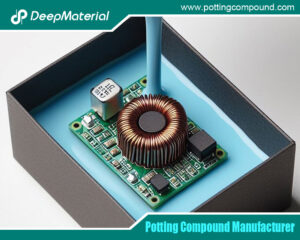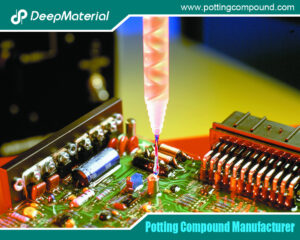

Unveiling the Power of Potting Compounds for Electronics: Enhancing Performance, Protection, and Reliability
- Electronic Potting Material Manufacturer
- June 26, 2024
- adhesive glue manufacturer, electrical potting compound, electronic epoxy encapsulant potting compounds, electronic potting compound, Electronic Potting Compounds Manufacturer, Encapsulants and Potting Compounds Suppliers, epoxy potting compound, epoxy potting compound manufacturers, industrial adhesive suppliers, polyurethane potting compound, polyurethane potting compound for electronics, Polyurethane Potting Compound Manufacturer, polyurethane potting compound manufacturers china, potting compound, potting compound for electronics, potting compound for pcb, potting compound vs epoxy, potting compounds for electronics, potting material for electronic components, potting material for electronics, potting pcb, silicone potting compound for electronics, thermal potting compound, UV curing potting compound, waterproof potting compound
Unveiling the Power of Potting Compounds for Electronics: Enhancing Performance, Protection, and Reliability
In the intricate world of electronic devices, where functionality, durability, and reliability are paramount, the role of potting compounds is often understated yet indispensable. Potting compounds, also known as encapsulants or potting resins, play a pivotal role in safeguarding sensitive electronic components from a myriad of environmental stresses, ensuring optimal performance and longevity. This article delves into the multifaceted realm of potting compounds, exploring their composition, applications, benefits, and the evolving landscape of electronics encapsulation.
Understanding Potting Compounds:
Potting compounds are specially formulated materials designed to encapsulate electronic assemblies, providing mechanical support, electrical insulation, and protection against environmental factors such as moisture, dust, chemicals, and vibrations. These compounds typically consist of a polymer base, such as epoxy, polyurethane, silicone, or a hybrid combination, along with various additives to impart specific properties.
Epoxy Resins:
Epoxy-based potting compounds are renowned for their exceptional mechanical strength, chemical resistance, and adhesion properties. They offer superb protection against moisture ingress and can withstand a wide range of temperatures, making them ideal for demanding applications in harsh environments. Moreover, epoxy resins cure through a chemical reaction, forming a robust, inert matrix that effectively encapsulates delicate electronic components.

Polyurethane Resins:
Polyurethane potting compounds are prized for their flexibility, low shrinkage, and excellent electrical insulation properties. They exhibit good adhesion to a variety of substrates and provide superior resistance to thermal cycling and shock. Polyurethanes are often preferred for applications requiring vibration dampening or thermal management due to their ability to dissipate heat efficiently.
Silicone Resins:
Silicone-based potting compounds are renowned for their remarkable flexibility, wide operating temperature range, and exceptional dielectric properties. They offer excellent resistance to moisture, UV radiation, and chemicals, making them well-suited for outdoor or aerospace applications where exposure to harsh conditions is common. Silicone resins maintain their elasticity over a broad temperature range, ensuring reliable performance in extreme environments.
Hybrid Formulations:
Hybrid potting compounds combine the desirable attributes of multiple resin chemistries to achieve tailored properties that meet specific application requirements. For instance, a hybrid formulation may blend epoxy for mechanical strength with silicone for enhanced flexibility and environmental resistance. These versatile compounds offer engineers greater flexibility in optimizing performance while maintaining cost-effectiveness.
Applications of Potting Compounds:
The versatility and efficacy of potting compounds find application across a diverse range of industries and electronic devices:
- Automotive Electronics: Potting compounds are extensively utilized in automotive electronics to protect control modules, sensors, and wiring harnesses from moisture, chemicals, and temperature extremes. Potting compounds enhance reliability and durability by encapsulating sensitive components, ensuring optimal performance under challenging operating conditions.
- Consumer Electronics: In consumer electronics, such as smartphones, tablets, and wearable devices, potting compounds play a crucial role in safeguarding delicate circuitry from environmental hazards and physical damage. These compounds enhance product longevity and reliability by encapsulating components, contributing to customer satisfaction and brand loyalty.
- Industrial Automation: Potting compounds are widely used in industrial automation systems to protect electronic controllers, sensors, and actuators deployed in harsh manufacturing environments. By providing electrical insulation and environmental protection, these compounds enable seamless operation of automation equipment, minimizing downtime and maintenance costs.
- Aerospace and Defense: In the aerospace and defense sectors, where reliability and performance are mission-critical, potting compounds are employed to protect avionics, communication systems, and electronic warfare equipment from the rigors of flight and combat. These compounds withstand extreme temperatures, altitude changes, and vibration, ensuring uninterrupted operation of critical systems.
Benefits of Potting Compounds:
The adoption of potting compounds offers numerous benefits for electronic assemblies:
- Environmental Protection: Potting compounds shield electronic components from moisture, dust, chemicals, and other environmental contaminants, prolonging their service life and enhancing reliability in adverse conditions.
- Mechanical Reinforcement: Potting compounds provide mechanical support by encapsulating fragile components, preventing damage from shock, vibration, and physical impact. This reinforcement is particularly crucial in applications subject to mechanical stress or handling.
- Electrical Insulation: Potting compounds insulate electronic circuits and components, reducing the risk of short circuits and electrical failures. This insulation is essential for maintaining signal integrity and preventing leakage currents, especially in high-voltage or high-frequency applications.
- Thermal Management: Certain potting compounds exhibit excellent thermal conductivity, dissipating heat generated by electronic components and improving thermal management. Effective heat dissipation helps prevent overheating, extends component life, and enhances system reliability.
- Design Flexibility: Potting compounds’ diverse properties and compatibility with various substrates and manufacturing processes offer engineers flexibility in designing and optimizing electronic assemblies for specific performance requirements and environmental conditions.

The Evolving Landscape:
As electronic devices become increasingly compact, complex, and integrated into everyday life, the demand for advanced potting compounds continues to grow. Manufacturers are innovating to develop formulations offering enhanced performance, reliability, and sustainability while addressing challenges such as miniaturization, high-speed communication, and environmental regulations.
The continual evolution of potting compounds is driven by a myriad of factors, including advancements in material science, evolving industry standards, and the ever-changing landscape of electronic applications. Here are some notable trends shaping the future of potting compounds:
- Miniaturization and High-Density Packaging: As electronic devices trend toward smaller form factors and higher component densities, potting compounds must adapt to meet the challenges posed by miniaturization. Formulations that offer ultra-low viscosity, excellent flow properties, and precise dispensing capabilities are crucial for encapsulating densely packed assemblies without compromising performance or reliability.
- High-Speed Electronics: With the proliferation of high-speed communication protocols and data-intensive applications, potting compounds must address the challenges posed by signal integrity, electromagnetic interference (EMI), and crosstalk. Advanced formulations with tailored electrical properties, such as controlled dielectric constants and low-loss tangents, are essential for preserving signal integrity and minimizing EMI in high-frequency circuits.
- Environmental Sustainability: In response to growing environmental concerns and regulatory pressures, there is a rising demand for eco-friendly potting compounds that minimize the use of hazardous substances and reduce the ecological footprint of electronic products. Manufacturers are exploring renewable, biodegradable, and recyclable materials as alternatives to traditional resin chemistries, promoting sustainability throughout the product lifecycle.
- Flexible and Stretchable Electronics: The emergence of flexible and stretchable electronics for wearable devices, medical implants, and conformal sensors presents unique challenges for potting compounds. Formulations that offer exceptional flexibility, elongation, and adhesion to stretchable substrates are essential for encapsulating flexible circuits and ensuring reliable performance under dynamic mechanical stress.
- Advanced Manufacturing Techniques: Additive manufacturing, such as 3D printing, is revolutionizing the production of electronic assemblies, offering unparalleled design freedom and customization capabilities. Potting compounds compatible with additive manufacturing processes enable the rapid prototyping and fabrication of complex, customized enclosures for electronic devices, streamlining product development and time-to-market.
- Innovative and Self-Healing Materials: Integrating intelligent functionalities, such as self-healing and self-diagnostic capabilities, into potting compounds can revolutionize electronic encapsulation. Self-healing materials can repair minor cracks and defects autonomously, enhancing the durability and longevity of encapsulated assemblies. At the same time, self-diagnostic features enable real-time monitoring of encapsulation integrity and performance.
- Industry 4.0 and IoT Integration: With the advent of Industry 4.0 and the Internet of Things (IoT), there is a growing need for potting compounds that can withstand the demands of interconnected, autonomous systems in smart factories and IoT-enabled devices. Potting compounds with enhanced resistance to cyber-physical threats, such as tampering, hacking, and electromagnetic pulse (EMP), are essential for ensuring the security and reliability of critical infrastructure and IoT ecosystems.
In conclusion, the future of potting compounds is characterized by innovation, adaptation, and sustainability as manufacturers strive to meet the evolving needs of the electronics industry while addressing emerging challenges and opportunities. By embracing new materials, technologies, and manufacturing processes, potting compounds will continue to play a vital role in safeguarding electronic assemblies, enhancing performance, and realizing next-generation electronic devices and systems.
For more about unveiling the power of potting compounds for electronics: enhancing performance, protection, and reliability, you can pay a visit to DeepMaterial at https://www.pottingcompound.com/ for more info.
Recent Posts
- Potting Compound vs. Epoxy: A Comprehensive Comparison
- Potting Compound for PCB
- In – depth Analysis of the Curing Characteristics of Electronic Potting Compounds
- A Comprehensive Analysis of the Environmental Performance of Encapsulating Materials: From Regulations to Practices
- A Comprehensive Analysis of PCB Encapsulation Quality Inspection: Innovative Application of Non-Destructive Testing Technologies
- Analysis of the Improvement of the Seismic and Impact Resistance Performance of PCB by Encapsulation
- A Comprehensive Guide to Evaluating the Reliability of Encapsulation Materials for Encapsulated PCBs
- In-depth Analysis of the Reparability of Encapsulation Materials
- A Comprehensive Analysis of Post-Potting PCB Issues and the Repair and Rework of Potting Materials
- A Comprehensive Analysis of the Compatibility between Encapsulation Materials and PCBs: Exploration of Chemical Reactions and Their Impact on Performance





